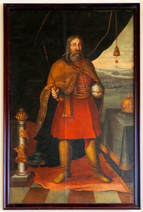
Stephen (later named St. Stephen) was crowned king on January 1 in the year 1000 AD. He was the first Christian king. Among other things he established Latin as the official language, which it remained until 1844. For several decades in the early 1800's there was a struggle to renew the Hungarian language and then replace the dead Latin language.
The size of the country was once three times larger than modern Hungary. It has shrunk, grown and shrunk again through numerous wars. For a while Hungary was part of the Ottoman Empire. In the late 1800's the nation of Austria-Hungary was the second largest in Europe after the Russian Empire.
I feel that the museum has a stronger exhibit on WWI than of WWII, but both are lightly treated. I suppose that if I sit back and think about all the full historical timeline, the coverage is appropriate and I was just expecting more emphasis. I hadn't realized that following the collapse of pacifism after WWI that the Hungarian Social Republic was established and formally lead by a Social Democrat, but in practice lead by the Communists. I always assumed that Communism came after WWII. This communistic time was followed by a counter-revolution of "white army". The time between the World Wars must have been extremely turbulent.
After WWII the name of the county was changed to the People's Republic of Hungary and the constitution was modeled after the Soviet constitution. Socialism was named to be the main goal of the nation. It lead to a period of near-dictatorship and secret police. This system deteriorated over time.
In October 1989, the Parliament adopted legislation providing for multi-party parliamentary elections and a direct presidential election. Hungary would become a fully free and democratic system.




 RSS Feed
RSS Feed